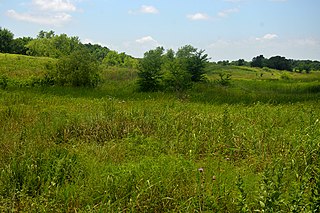Related Research Articles

The Piney Woods is a temperate coniferous forest terrestrial ecoregion in the Southern United States covering 54,400 square miles (141,000 km2) of East Texas, southern Arkansas, western Louisiana, and southeastern Oklahoma. These coniferous forests are dominated by several species of pine as well as hardwoods including hickory and oak. Historically the most dense part of this forest region was the Big Thicket though the lumber industry dramatically reduced the forest concentration in this area and throughout the Piney Woods during the 19th and 20th centuries. The World Wide Fund for Nature considers the Piney Woods to be one of the critically endangered ecoregions of the United States. The United States Environmental Protection Agency (EPA) defines most of this ecoregion as the South Central Plains.

The Texas Blackland Prairies are a temperate grassland ecoregion located in Texas that runs roughly 300 miles (480 km) from the Red River in North Texas to San Antonio in the south. The prairie was named after its rich, dark soil. Less than 1% of the original Blackland prairie vegetation remains, scattered across Texas in parcels.

Nerodia is a genus of nonvenomous colubrid snakes commonly referred to as water snakes due to their aquatic behavior. The genus includes nine species, all native to North America.

The banded water snake or southern water snake is a species of mostly aquatic, nonvenomous, colubrid snakes endemic to the Midwest and Southeastern United States.

Lampropeltis getula, commonly known as the eastern kingsnake, common kingsnake, or chain kingsnake, is a harmless colubrid species endemic to the United States and Mexico. It has long been a favorite among collectors. Nine subspecies are currently recognized, including the nominate subspecies described here.
In the 10th edition of Systema Naturae, Carl Linnaeus described the Amphibia as:
Animals that are distinguished by a body cold and generally naked; stern and expressive countenance; harsh voice; mostly lurid color; filthy odor; a few are furnished with a horrid poison; all have cartilaginous bones, slow circulation, exquisite sight and hearing, large pulmonary vessels, lobate liver, oblong thick stomach, and cystic, hepatic, and pancreatic ducts: they are deficient in diaphragm, do not transpire (sweat), can live a long time without food, are tenatious of life, and have the power of reproducing parts which have been destroyed or lost; some undergo a metamorphosis; some cast (shed) their skin; some appear to live promiscuously on land or in the water, and some are torpid during the winter.

The common watersnake is a species of large, nonvenomous, common snake in the family Colubridae. The species is native to North America. It is frequently mistaken for the venomous cottonmouth.
References
- 1 2 Beane, Jeffrey C.; Braswell, Alvin L. (2011). "Checklist of the Amphibians and Reptiles of North Carolina" (PDF). North Carolina Museum of Natural Sciences. Retrieved September 17, 2017.
- 1 2 "Checklist of North Carolina Reptiles". North Carolina Museum of Natural Sciences. 2005. Archived from the original on March 23, 2009. Retrieved September 17, 2017.
- ↑ Crother, Brian I., ed. (2017). Scientific and Standard English Names of Amphibians and Reptiles of North America North of Mexico, with Comments Regarding Confidence in our Understanding (PDF). (8th ed.). Herpetological Circular No. 43. Shoreview, MN: Society for the Study of Amphibians and Reptiles. ISBN 978-1-946681-00-3 . Retrieved February 17, 2018.
- ↑ Crother, Brian I., ed. (2012). Scientific and Standard English Names of Amphibians and Reptiles of North America North of Mexico, with Comments Regarding Confidence in our Understanding (PDF). (7th ed.). Herpetological Circular No. 39. Shoreview, MN: Society for the Study of Amphibians and Reptiles. ISBN 978-0-916984-85-4 . Retrieved September 17, 2017.
- ↑ Crother, Brian I., ed. (2008). Scientific and Standard English Names of Amphibians and Reptiles of North America North of Mexico, with Comments Regarding Confidence in our Understanding (PDF). (6th ed.). Herpetological Circular No. 37. Shoreview, MN: Society for the Study of Amphibians and Reptiles. ISBN 0-916984-74-5 . Retrieved September 17, 2017.
- ↑ Braswell, Alvin L.; Palmer, William M.; Beane, Jeffrey C. (2003). Venomous Snakes of North Carolina (PDF). Raleigh: North Carolina State Museum of Natural Sciences. ISBN 0-917134-24-9 . Retrieved September 17, 2017.